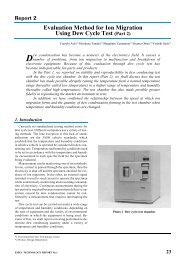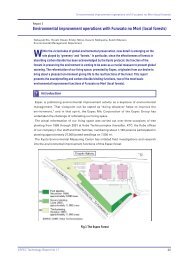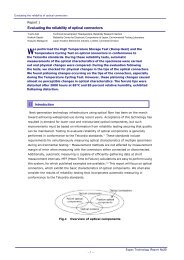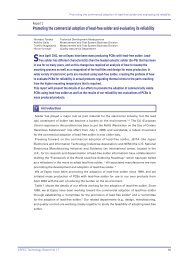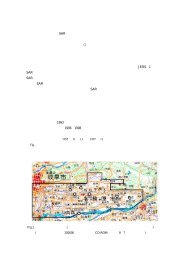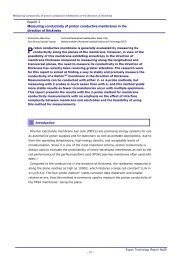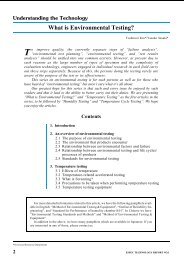download
download
download
You also want an ePaper? Increase the reach of your titles
YUMPU automatically turns print PDFs into web optimized ePapers that Google loves.
Measuring Conductivity of Proton Conductive Membrane in the direction of thickness, partⅡ:<br />
using the 4-probe method in the direction of thickness<br />
Table 2 Effects of hot-pressing conditions and electrode material<br />
on MEA measuring performance<br />
Hot-pressing temperature<br />
/ pressure<br />
Forming method<br />
/ electrode material<br />
One-step<br />
Two-step*<br />
Teflon-Pt<br />
Varnish-Pt<br />
Polyester-Cu<br />
150℃ 80℃<br />
40 kgf cm -2 200 kgf cm -2 400 kgf cm -2 40 kgf cm -2 200 kgf cm -2 400 kgf cm -2<br />
Stretched<br />
coating<br />
Unstable<br />
performance<br />
Poor<br />
performance<br />
Wire break,<br />
Stretched<br />
coating<br />
- 10 -<br />
Wire break,<br />
Stretched<br />
coating<br />
Wire break Wire break<br />
Poor<br />
performance<br />
Wire break<br />
Teflon-Pt - - -<br />
Varnish-Pt - - -<br />
Polyester-Cu - - -<br />
Stretched<br />
coating<br />
Unstable<br />
performance<br />
Good<br />
performance<br />
Stretched<br />
coating<br />
Good<br />
performance<br />
Excellent<br />
performance<br />
Wire break,<br />
Stretched<br />
coating<br />
Wire break,<br />
Stretched<br />
coating<br />
Wire break Wire break<br />
Poor<br />
performance<br />
Stretched<br />
coating<br />
Unstable<br />
performance<br />
Good<br />
performance<br />
Poor<br />
performance<br />
Wire break,<br />
Stretched<br />
coating<br />
Poor<br />
performance<br />
Unstable<br />
performance<br />
*:Reference electrode wires were previously imbedded into electric current lead-in membranes<br />
by hot-pressing at 150℃ and 400 kgf cm -2 for 1 min in the first step<br />
The one-step method in MEA manufacturing refers to a technique in which the MEA specimen is<br />
completed using a single hot-pressing process with the laminate stack sandwiched by two electric<br />
current lead-in membranes, two reference electrode wires, and one test membrane. Using the<br />
one-step method, shown in Table 2, MEA specimens prepared at relatively lower temperature or<br />
pressure afforded a comparatively higher measuring performance for all three reference<br />
electrode materials used, more obviously in the case of Cu/polyester coated wire. On the other<br />
hand, measuring performance of the MEA specimens was enhanced dramatically with the<br />
two-step method, which features a preceding hot-pressing process by which the reference<br />
electrode was imbedded into the electric current lead-in membranes. The results exhibited the<br />
marked effectiveness of the two-step method over the one-step method. Moreover, Table 2 also<br />
reveals an increase in the measuring performance of the MEA specimens with the use of<br />
electrode material in the following order: Pt/Teflon, Pt/varnish, and Cu/polyester.<br />
Microscope analysis was used to clarify the mechanism of failure of the MEA specimens,<br />
observing and analyzing reference electrodes that underwent hot-pressing treatments. Typical<br />
failure examples of reference electrodes are shown in Photo 1. These failures occurred after first<br />
undergoing a hot-pressing process in the first step when using the two-step method.<br />
Espec Technology Report No.23



